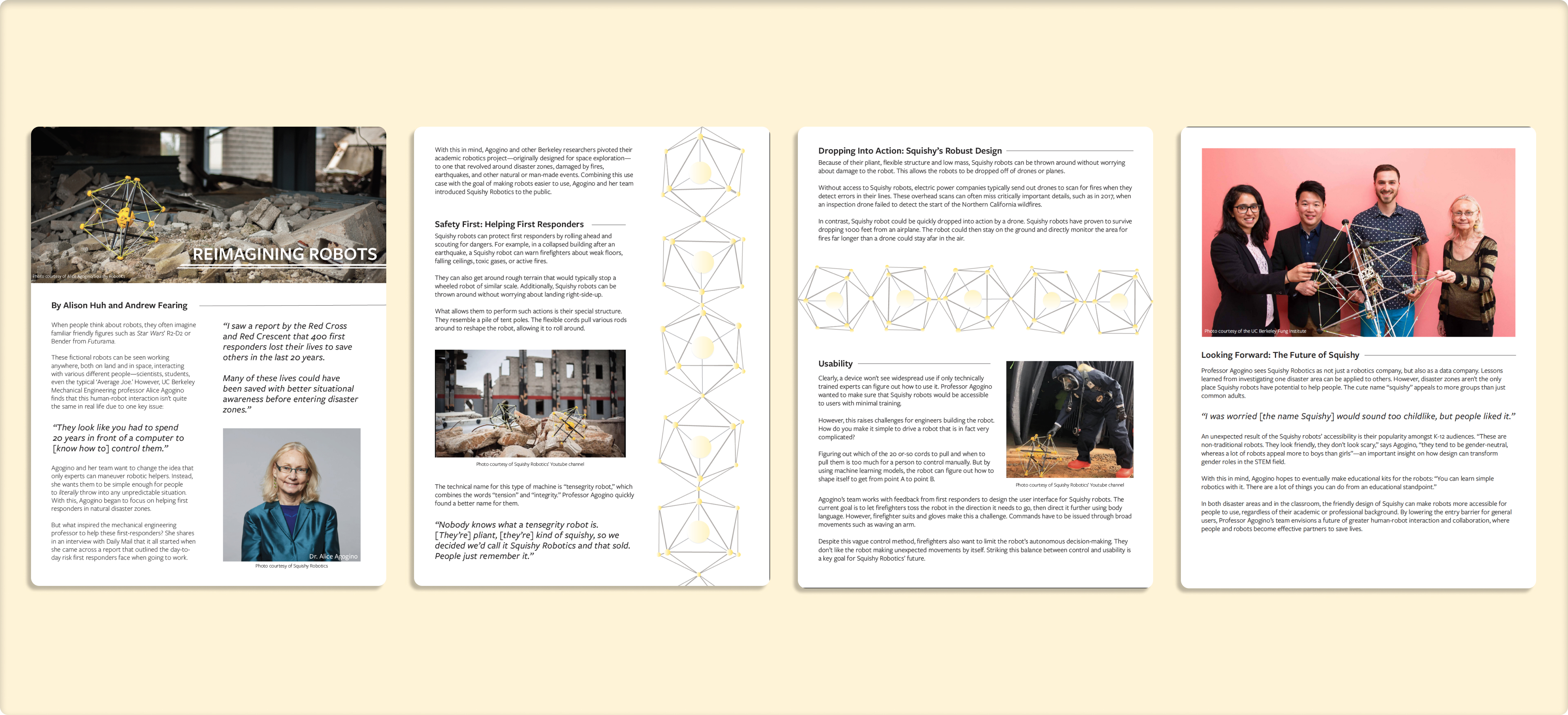Engineering 185:
The Art of STEM Communication
Role —
Writer + Designer
Team —
Andrew Fearing, co-author
Duration —
January 2020 to May 2020
Overview —
During the spring 2020 semester, I took Engineering 185: The Art of STEM Communication,
which was a class focused on helping engineering students hone in on their technical
communication skills. For our semester-long project, we interviewed Mechanical
Engineering Professor and Squishy Robotics CEO Alice Agogino, covering her research
and motivations for pursuing Squishy Robotics.
Read full article ↗

Project Goal
Help non-technical audiences newly discover the value in technical projects.
Researching Squishy Robotics
Squishy Robotics is a start-up, led by Alice Agogino, that builds mobile sensing tensegrity robots for disaster rescue, remote monitoring, and space exploration applications.
Before we could immediately request Professor Agogino for an interview,
my project partner Andrew and I decided to gather as much background
information as we could in order to plan ahead and make the most of
readily-available online information. We dove in to press releases, news
articles, and research papers to learn about Squishy Robotics at a
wide range of technical complexity.
Once we had a solid general understanding about Squishy Robotics,
we interviewed Professor Agogino, asking about the origins of the robot
and its applications both in and out of disaster relief.
An Unexpected Turn
Days after our first interview, we — like much of the world at the time — dealt with the abrupt transition to remote learning.
The biggest challenge that came out this transition was the sudden difficulty
we experienced in trying to communicate with our points of contact. As
research labs locked down and companies shifted to remote work, impacting access to
Squishy's SMEs (Subject Matter Experts), Andrew and I pivoted the focus of
our article to one that looked at the higher-level impacts of Squishy Robotics.
With this, we tried to emphasize why the general population should care about
the work Squishy Robotics was doing, and how it may impact them.
It was definitely an adjustment we had to intentionally make, given we originally
wanted to focus more on the technical intricacies of the robot. However, it proved
to humanize the story behind Squishy Robotics, telling how a purely academic idea
was transformed into a life-saving tool and a valuable educational opportunity.
Key Takeaways
Finding new interests I can pursue with my written skills.
Having only written literary essays my entire academic career at this point,
this class made me realize how inaccessible my writing style was beforehand.
I noticed in hindsight that in my writing, I constantly was trying too hard
to sound sophisticated and overcomplicating my sentences in the process.
As a result of this project, my writing process drastically transformed to consider
the reader, or user, on the other side, reading my work.
On top of that, this class gave me the unique opportunity to dive into the engineering
ecosystem of Berkeley. Until then, my only exposure to the College of Engineering was my
limited perspective as a marketing intern for the MEng program. Just finding out how much
research is actively being run, it made me want to help others discover new advancement
engineerings.
While this assignment was not the most technically challenging, it helped spark my interests
in technical writing and documentation because at the end of the day, what I wanted to achieve
most was to help non-technical people like me understand the complex tech that
made things like Squishy Robotics so cool and impactful even in everyday life.